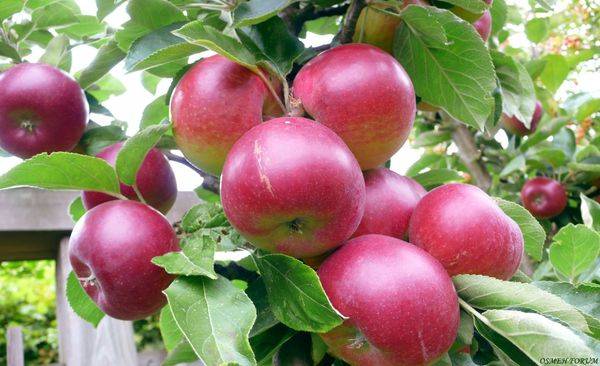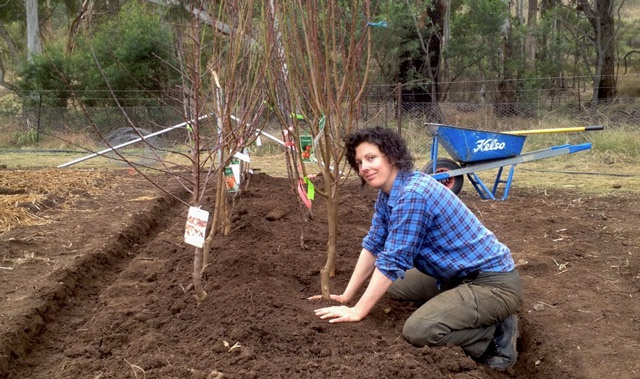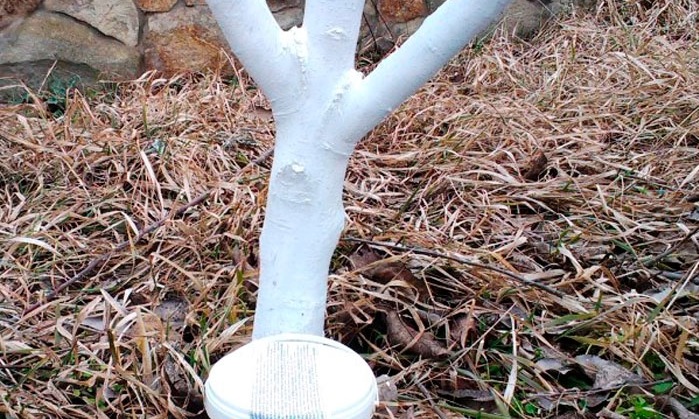Content:
The variety is of paramount importance in the cultivation of an apple tree. The possibility of growing a particular variety is determined by its varietal characteristics. One of the most promising apple varieties today is Legend.
Variety history
The apple tree is the most widespread fruit crop in the world. These are perennial woody or shrub plants from the Pink family. The culture is divided into 62 species, the total number of varieties of which exceeds 10 thousand.
Apple variety Legenda was bred in 1982 by the staff of VSTISP (Moscow). It comes from the crossing of the Japanese variety Fuji - one of the most famous apple varieties in our time - and the domestic variety Brusnichnoye. Since 2008, the variety has been in the State Register of Breeding Achievements.
Description of Apple Legend
The tree is columnar, compact, the number of branches is minimal. It reaches a height of no more than 3 m, suitable for cultivation in intensive apple orchards. The crown is small, placed compactly. The foliage is ovoid.
Growing
Landing
The procedure for planting a seedling is usually carried out either in the middle of autumn, or in 10-20 days of April. Seedlings should be purchased from trusted sellers. The planting material must be healthy, without the presence of traces of diseases, damage from pests and mechanical damage, and the root system must be flexible. Foliage may be absent, since sometimes it is specially removed so that the seedling does not dry out.
The plot for cultivation of Legends must be protected from winds, the soil is loose. It is desirable that the groundwater is as deep as possible.
The depth of the planting hole varies according to the length of the seedling. It is necessary that the root collar exceeds the soil level by 6-7 cm. It should be comfortably placed in the hole so that the roots do not bend.
The hole is prepared approximately 25-30 days before planting the seedling. This is necessary so that the hole has time to settle and crumble. A wooden peg 0.5-1 m long is driven into the hole with a pointed end inward.
On the day of planting, too elongated or injured roots are removed. The seedling is placed inside the hole and the roots are straightened so that they are not twisted. The tree is installed on the north side of the peg and tied with a piece of twine, twisted like a figure of eight. The hole is covered with soil and lightly tamped.
At the end, in the near-stem sector, a shallow hole is dug into which several buckets of water are poured. After that, fertilizing is carried out by diluting 1 tbsp in a bucket of water. spoons of saltpeter and shovels of manure. 2 liters of homemade organic fertilizer are poured under each new seedling. Then mulching is carried out to retain moisture in the soil. It is recommended to use soil from the same plot as a material for mulching.
The Legenda variety belongs to the self-fertile category, that is, it is not able to form a full-fledged crop without pollination from the outside.The following varieties can be used as pollinators:
- Melba;
- Borovinka;
- Sinap North.
Watering
Irrigation is carried out depending on the age of the tree, as well as on the weather and climatic conditions. Young seedlings need to be watered more often than mature trees. At the same time, old plants require more liquid for themselves, while seedlings at a young age cost 2-3 buckets of water.
In general, about 4-5 irrigations are usually carried out in spring and summer. At the end of each procedure, it is recommended to loosen the soil in the near-stem sector so that the root system is better saturated with moisture and air. At the same time, it is recommended to remove the weed.
Top dressing
In order for a young seedling to take root faster, it is recommended to apply liquid carbamide or nitrate 3 times per season. The next year after planting, the first top dressing is carried out in early spring. To do this, 0.7 kg of manure is bred in a bucket of water and mixed thoroughly, after which the plant is fed with the resulting solution.
At the end of flowering, the tree should be fed with a mixture of mineral fertilizers. It is prepared by dissolving the following ingredients in 10 liters of water:
- 40 g calcium;
- 60 g of carbamide;
- 100 g superphosphate.
There is another option for such feeding, no less effective. Dissolve in the same volume of water:
- 45 g superphosphate;
- 0.5 kg of poultry droppings;
- 1 kg of liquid cow manure.
Fertilizers are applied after harvesting. For its preparation, 40-50 g of superphosphate is dissolved in a 10-liter container with water.
Pruning
In the first year after planting the seedling, it is recommended to remove only a third of the shoots. A year later, the formation of the crown is carried out in order to obtain branches placed in 3 tiers as a result. In all subsequent years, pruning should be aimed at preserving the center conductor. It should be borne in mind that you cannot delete more than a quarter of all branches in the tree.
During the growing season, you need to get rid of damaged, injured, dried out branches, as well as those that create excessive thickening in the crown. After removing each shoot, carefully coat the cut site with garden pitch.
Diseases and pests
The legend shows increased resistance to most diseases of apple trees, however, with insufficient care, plants can be affected by powdery mildew, scab, and bitter pits. Disease control involves regular inspection of plants for signs of disease. Affected shoots are cut out, treating the cut site with chalk on young seedlings and lime mortar on older plants. When the apples are harvested, the crown is sprayed with a 3-5% solution of copper sulfate. In early spring, before bud break, plantings are sprayed with Fitosporin-M.
The Legend can be attacked by pests. For prevention, appropriate insecticides are used.
Preparation for wintering
For winter, the Legend variety is prepared within 2 weeks after the crop has been harvested. First of all, mulch is removed from the near-trunk sector and the soil is dug up next to the tree. After that, the apple tree is fed with phosphorus-potassium fertilizers, which help strengthen the root system and heal injuries and injuries.
The availability of moisture to the plant also affects the success of wintering. The last irrigation is carried out when the fruits are finally formed and ripe, while watering should not be too voluminous and strong.
In winter, the wood on the trunk can be damaged by hares, so it is covered with roofing material, cardboard or special covering material. In the near-trunk circle, spruce branches can be laid out, which will contribute to snow retention. Fallen leaves are not used to cover the tree, which can become a refuge for rodents.
It is recommended to remove the dead surface layer of the bark from the trunk, and then whitewash with lime with a diluted fungicide in it. This will protect the planting from sunburn and damage from negative temperatures.
On young plantings, hilling is carried out to a height of about 30-40 cm and mulch with a 3-4-cm layer of peat. This procedure is carried out if the frost occurred earlier than the snow fell.
Advantages and disadvantages
Apple tree Legend is characterized by many positive properties, the most important of which are:
- resistance to major diseases;
- excellent marketability and taste;
- adaptability and plasticity;
- high level of winter and frost resistance;
- columnar;
- easy care.
According to the above properties, the Legend surpasses most of the apple assortment. The variety has no significant drawbacks, there are only a few minor ones:
- short tree life (usually no more than 15 years);
- high cost of seedlings.
















